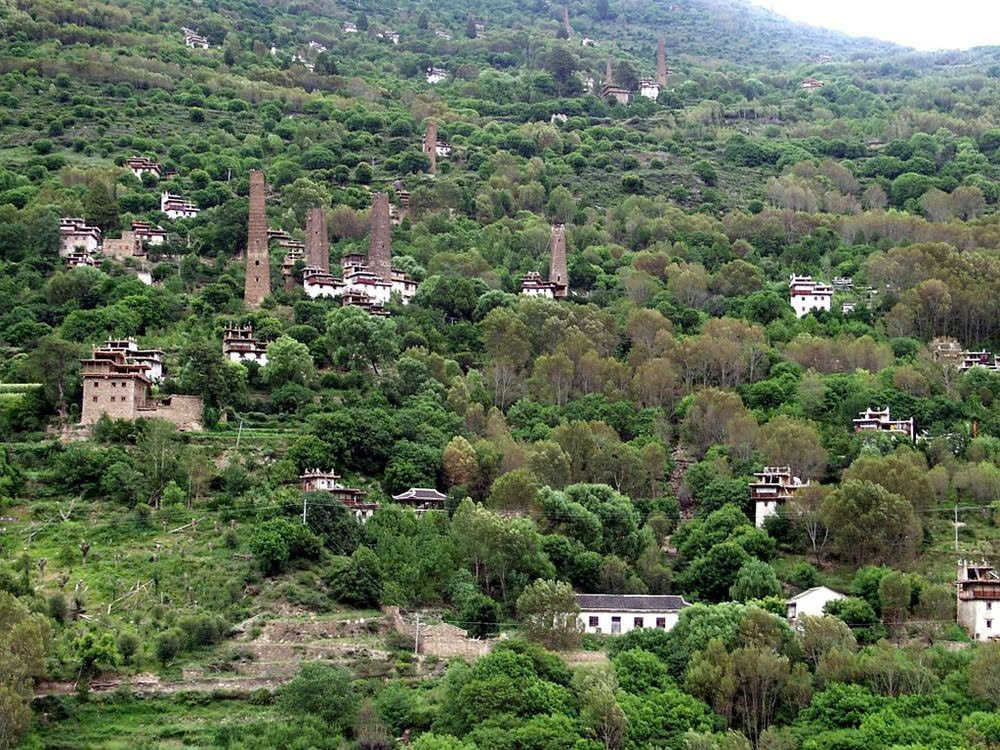Deep within the rugged landscapes of Western Sichuan province, where the boundaries between central China and the Tibetan Autonomous Region blur into mountain mist, hundreds of ancient stone towers pierce the sky like silent sentinels. These remarkable structures, some soaring beyond 200 feet into the thin mountain air, stand as one of archaeology’s most perplexing enigmas.
A Landscape Dotted with Ancient Giants
The Scattered Monuments
Scattered across the valleys and hillsides of the Himalayan foothills, these towering monuments create an otherworldly landscape. Today, many serve humble purposes—converted into shelters for yaks and ponies by local villagers who have inherited these architectural marvels without understanding their origins. Others stand abandoned, their wooden staircases long since rotted away and their roofs collapsed under the weight of centuries.

Despite their obvious antiquity and the fact that they have dominated this landscape for generations, the towers remain shrouded in mystery. Even the communities living in their shadows possess no knowledge of who constructed these imposing structures or why they were built.
The French Explorer’s Quest
An Unexpected Discovery
The towers first captured international attention through the work of French explorer Frederique Darragon. In 1998, Darragon journeyed to Tibet with the intention of studying snow leopards, but found herself captivated by these mysterious architectural giants instead. What began as a wildlife research expedition transformed into a five-year obsession with unlocking the secrets of these ancient structures.

A Methodical Investigation
Darragon’s dedication to understanding the towers was comprehensive and meticulous. She cataloged each structure, created detailed maps of their locations, captured extensive photographic documentation, and even scaled the accessible towers to collect wood samples from their ancient beams for scientific analysis. Her conversations with local residents, however, yielded only frustration—nobody could explain the towers’ purpose or identify their builders.
Her search extended beyond oral histories to written records. While Buddhist monasteries in the region contained extensive libraries, they offered no insights into the towers’ origins. Chinese historical documents and the journals of 19th-century European travelers provided only brief mentions of these structures, with no serious attempts to study or understand them.
The Puzzle of Lost Knowledge
Cultural Fragmentation and Forgotten Histories
The absence of local knowledge about these monuments reflects the complex cultural and geographic reality of the region. For centuries, the areas surrounding the towers have been inhabited by diverse mountain tribes, each maintaining fierce independence and isolation. The challenging terrain has created a patchwork of communities speaking vastly different languages and dialects.
As Darragon observed in the documentary “Secret Towers of the Himalayas,” produced by her colleague Michel Peissel, the linguistic diversity was so extreme that “even from one valley to the next, the locals couldn’t speak to each other.” This fragmentation suggests that knowledge of the towers’ purpose may have once existed in oral traditions but disappeared as languages evolved or vanished entirely.
Architectural Marvels of Ancient Engineering
Construction Techniques and Design

The towers represent sophisticated examples of ancient engineering, constructed using a combination of precisely cut stone, brick, and timber. Their designs vary dramatically, featuring square, polygonal, and star-shaped configurations with some displaying up to twelve vertices. The builders employed minimal mortar, instead relying on wooden planks and beams interspersed between stones to create remarkably resilient structures.
Earthquake-Resistant Innovation
This construction technique proves particularly ingenious in a seismically active region. The flexible wooden elements allow the towers to absorb and dissipate the tremendous forces generated during earthquakes. The star-shaped designs appear especially effective at withstanding seismic activity, demonstrating an advanced understanding of structural engineering principles.
Unlocking the Timeline
Scientific Dating Reveals Ancient Origins
Through radiocarbon dating of wood samples collected from the towers, Darragon determined that these structures were built between 600 and 1,000 years ago. This timeline places their construction during a period of significant cultural and political change in the region, though the exact historical context remains unclear.
Multiple Purposes Across Different Valleys
Darragon’s research suggests that the towers served various functions depending on their location. In the Miniak valley, many appear to have functioned as watchtowers, evidenced by their elevated entrances positioned several stories above ground level and their strategic placement along ancient trade routes. In the Kongpo and Damba regions, the towers seem to have served as symbols of wealth and social status, possibly built by locals who prospered through trade with Mongol-ruled China.
Video
The Race Against Time
Preservation Challenges
Today, many of these remarkable structures face an uncertain future. Years of neglect have left numerous towers in various states of decay, their ancient timbers weathered and their stones beginning to shift. The gradual deterioration of these irreplaceable monuments has prompted urgent calls for preservation action.
International Recognition and Protection Efforts
Recognizing the towers’ significance, Darragon has spearheaded efforts to secure UNESCO World Heritage Site designation for these structures. Such recognition would not only provide international protection but also generate funding for restoration and conservation efforts. Additionally, she has sought support from Sichuan University to establish formal academic research programs focused on these enigmatic monuments.

In 2006, the stone towers achieved an important milestone when they were added to the World Monuments Fund’s watch list. This international non-profit organization, dedicated to preserving historic architecture and cultural heritage sites worldwide, has helped raise awareness of the towers’ vulnerability and the urgent need for conservation action.
An Enduring Mystery
The stone towers of Western Sichuan continue to stand as testament to the ingenuity and ambition of their unknown builders. While modern research has revealed some of their secrets—their age, construction techniques, and possible functions—the fundamental questions of who built them and why remain unanswered. These ancient monuments remind us that even in our interconnected world, mysteries endure, waiting patiently for future generations to unlock their secrets.
As preservation efforts continue and new research techniques emerge, perhaps one day these silent giants will finally reveal the full story of their creation and purpose. Until then, they remain one of the world’s most compelling archaeological puzzles, standing guard over their secrets in the thin air of the Himalayas.

